June 4, 2016
It’s 7:15 am, a disgustingly early time to be leaving the house. Today is market day, the day when all the local farmers bring their produce into town, and Maureen and I are hoping to find some dinner fixings for substantially less than grocery store prices.
The idea of visiting a South American market is exciting. Alison, who writes my favorite travel blog, has been to dozens, and she always takes such brilliant pictures. I don’t imagine the markets or my photography will be up to her standards, but I am looking forward to experiencing a South American market with my own eyes.
Our first stop of the day is the fish market. No one is there. Apparently the fishing fleet goes out around dawn, which was only an hour or so ago. As I said, disgustingly early on a Saturday.
Instead, we turn up the street in search of the mercado. Mercado means “market,” and in Puerto Ayora, the term “mercado” is a little confusing. There’s a permanent mercado on the west side of town. It’s a traditional store selling produce and such.
Then there’s what we would call the farmer’s market, which happens on the east side of town, close to where we’re staying. Both are called a mercado, and both are on the same street, about 8 blocks apart.
Today, we are heading to the farmer’s market, which happens every Saturday and Tuesday morning.
On our way, we pass some intriguing street art.

Blue-footed boobies are one of the most famous species in the Galapagos, though I suspect they’re famous more for the “boobies” reference than the bird itself. There are “I love boobies” T-shirts with blue feet on them in every tourist shop we’ve passed.
However, this is the first street art I’ve seen that builds on the “boobie” theme.
After about 15 minutes’ walk uphill, we turn left and there before us is the mercado. The bulk of the market is contained under this open-air shelter . . .
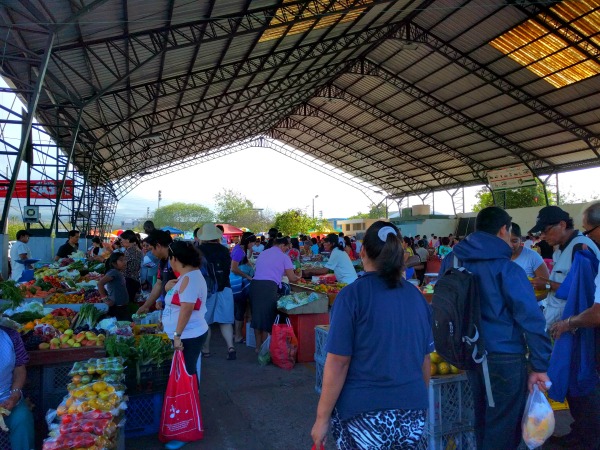
. . . but there are stalls spilling over into the side street as well.
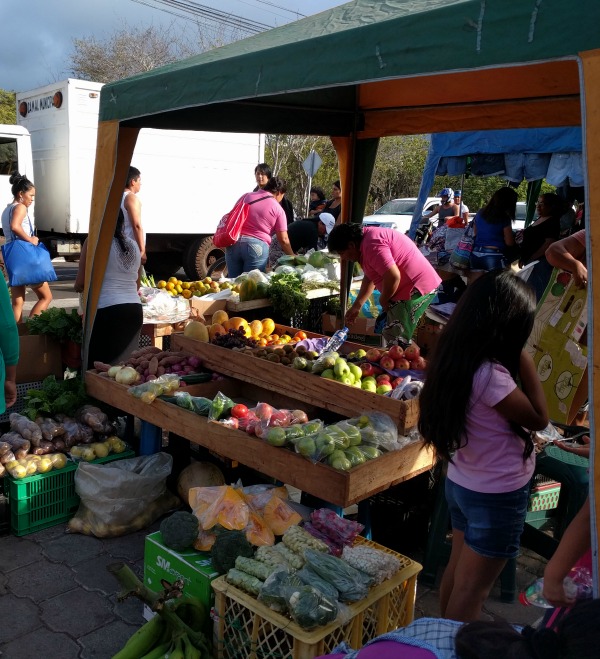
As we come up through the side street, the first few stalls are full of T-shirts, sunglasses, and other tourist paraphernalia.
As we plunge into the main market, though, we’re surrounded by stalls selling all kinds of fresh produce.
The market is busy, but surprisingly doesn’t feel overcrowded. There are a few tourists among the crowd, but most seem to be locals doing their weekly shopping.
Most of the stalls are selling fruits, corns, or beans.
I mistake a corn stall for a stall selling nuts (in my defense, the puffed corn kernels looked a lot like roasted peanuts).
There are some vegetable stands, mostly selling broccoli, cauliflower, carrots, potatoes, and onions. No garlic, which is strange and unfortunate. How do people live without garlic?
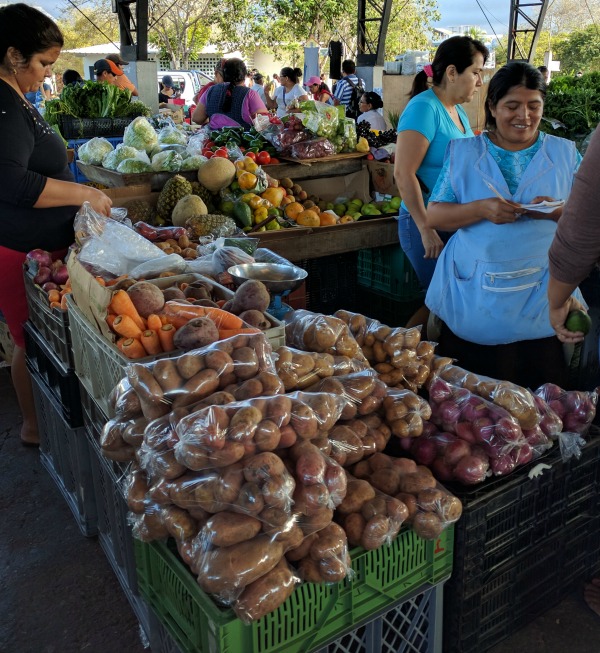
We buy some broccoli and cauliflower, but cannot find the organic local eggs we’re looking for. Nor can we find the fruit Maureen tells me tastes like custard. Probably just as well – it sounds too delicious to be healthy.
One fruit stand sells bananas still on the stalk, which I find most intriguing:
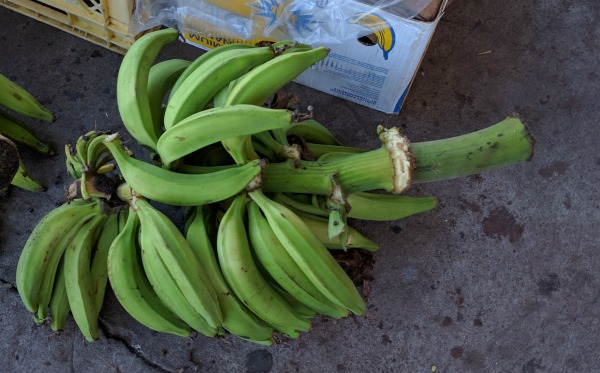
Given that there’s no source of fresh water on the island, I’m impressed with the variety of food for sale here. There’s not a lot of pork or beef, because the island can’t support them. But there’s plenty of fruits and veggies, and enough eggs and beans to make up a pretty healthy diet.
Most of the people at the market are dressed in modern clothes: jeans, T-shirts, aprons, shorts. But as we pass this stall on the outside of the market, I get my first glimpse of “traditional” women’s outfits.
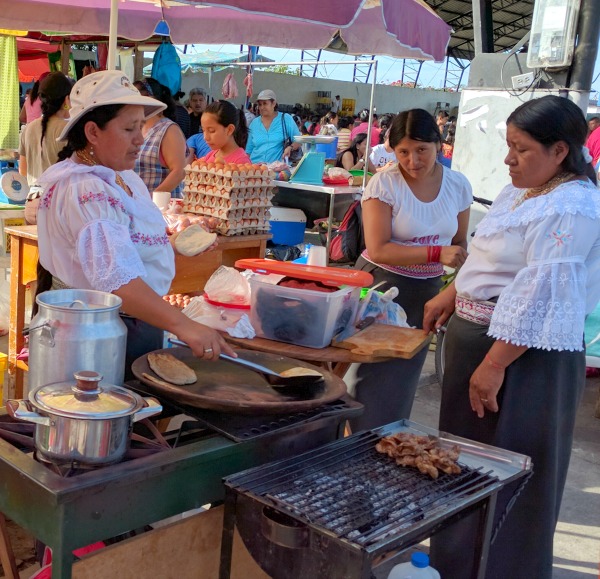
You can’t see it very well in this picture, but the vendor had on a gorgeous many-layered gold necklace. The necklace, the perfect white blouse with delicate embroidery, and the intricate beaded belt combine to blur the lines between the present day and the past.
As we leave the market, we stumble across a fish vendor. He tells us that his fish was brought in the night before and points to a white one that’s particularly delicious for grilling.
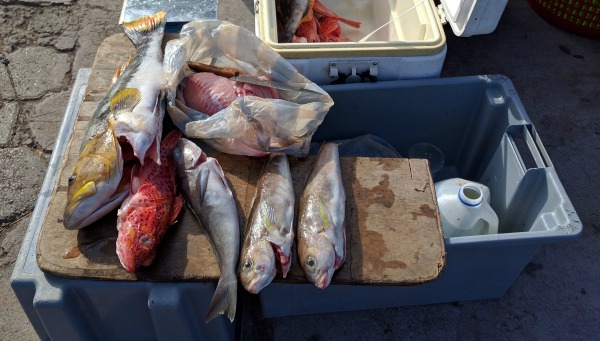
So far, the prices have been slightly lower than the grocery store, so when he quotes us a price of $1.50 each for two very generous white fish fillets, we are ecstatic.
When we get home, we decide to enjoy our vacation day and do nothing but lay around in the hammock and, in the afternoon, head out to the Playa de la Estación. I write the first batch of postcards and people watch from my bushy alcove.
Later that night, Maureen turns our market purchases into an amazing fish and veggies dinner. As promised, the fish is meaty, not flaky, and lacks the “fishy” taste that I dislike.
All in all, a successful and lazy day. Tomorrow morning we head out on a bay tour that stops five or six places in three hours. On the docket: sea lions, snorkeling, the Love Canal, and Las Grietas, a breathtakingly lovely clear water ravine.

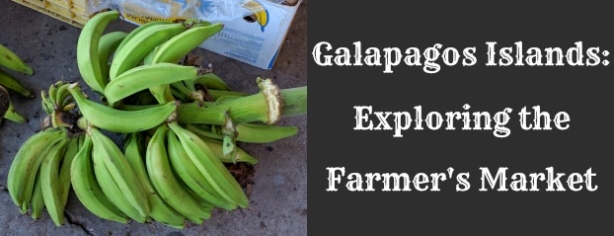









The south-central portion of Isla Santa Cruz appears to be devoted to agriculture — coffee (and fish) are actually exported.
Interesting to see bagged potatoes — given the potato’s origin near the Peru/Bolivia border, I guess it qualifies as a “local product”…
As your father mentioned, (we’re) enjoying the posts, keep it up…
The locals refer to the “high country” on Santa Cruz island. We did pass several farms on our way from the ferry dock. After all, not everyone can run a restaurant or operate a tour company!
As for the market, to call it a farmer’s market invokes the atmosphere, but there were certainly many things for sale that did not come from the islands themselves. Maureen recognized several of the fruits as imported from the mainland, and I’m pretty sure they don’t make T-shirts or sunglasses on the Galapagos Islands.
Actually, one can get by without garlic pretty easily!. I enjoy reading the posts…keep it up!
I don’t know how it’s possible to not have garlic. Garlic and onions are two things you can never have enough of. Along with butter, of course!